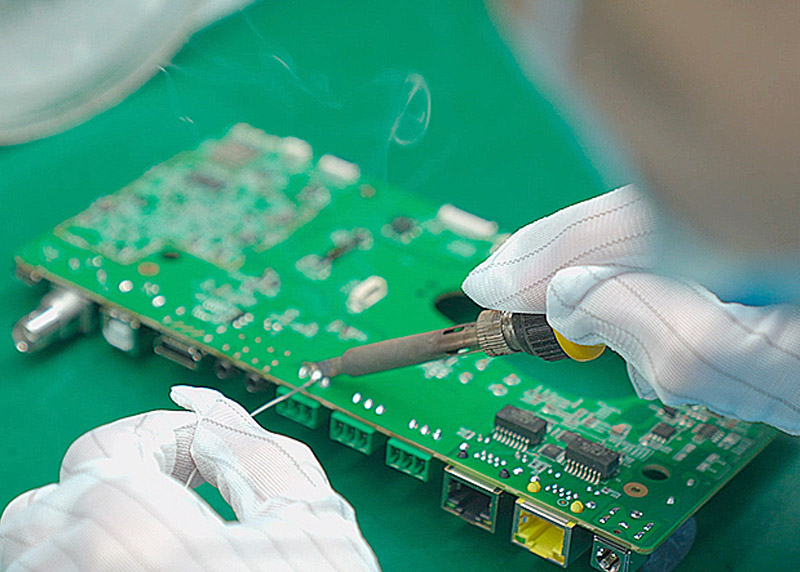
Quality soldering equipment is essential for achieving successful PCB assembly manufacturing. High-quality soldering equipment ensures precise temperature control, efficient heat transfer, and accurate soldering results.
Different types of soldering equipment, such as soldering irons, reflow ovens, etc.,
When selecting soldering equipment, look for a soldering iron with adjustable temperature settings to suit different soldering tasks. A soldering station with a digital temperature display can provide better control over the soldering process.
The quality of your soldering equipment directly affects the quality of your solder joints. Reliable equipment upfront can save you time, avoid rework, and ensure consistent results throughout your quick-turn PCB assembly projects.
The soldering iron tip size and shape play a significant role in achieving precise soldering results.
· Dimensions of Soldered Components
For smaller components, a fine tip is recommended to ensure accuracy and prevent any damage to nearby elements.
Larger components may require a bigger tip to facilitate efficient heat transfer
· Welding Technology Type
In general-purpose soldering, a chisel tip is commonly used as it provides a good balance between heat transfer and maneuverability.
intricate soldering tasks or working with tight spaces, a conical or pointed tip may be more suitable.
· Tips Are Compatible with Soldering Irons
Different soldering iron brands and models require specific tip designs, so be sure to check the specifications of your soldering iron and choose a compatible tip.
· Wave Soldering
The connection is made by passing the soldered parts through liquid solder along solder waves. Wave soldering is suitable for mass production, especially for the welding of plug-in components. It can complete multiple connections in a short time and improve production efficiency. For electronic products that require mass production and relatively simple soldering connections, wave soldering is an ideal choice.
· Manual Welding
In manual welding, the welder uses a soldering iron to solder electronic components one by one, which is very suitable for small batch production or scenarios that require high welding accuracy. This method requires welders to have a high degree of patience and meticulous work attitude and to be able to flexibly respond to various complex connection requirements. Manual welding has advantages in prototyping and small-scale custom production, providing more flexibility and personalization options for the welding process.
· Reflow Soldering
Reflow soldering technology realizes soldering by placing the entire PCB in a reflow oven and controlling the temperature and time. This method is suitable for surface mount technology (SMT) and is capable of soldering high-density, micro-small components. The advantage of reflow soldering is that it can complete multiple connections at once on the entire PCB, ensuring uniformity and consistency of soldering. For modern electronic products that require high component density and connection accuracy, reflow soldering is an indispensable technical choice.

For optimal soldering results, it is crucial to preheat the components and PCB before soldering.
Preheating helps remove moisture from components and PCBs, prevents the formation of microscopic air bubbles, ensures reliable and high-quality solder joints, and can minimize the thermal shock that components may suffer during the soldering process.
Preheating Components and PCB Methods:
One: use a heat gun or preheating oven to distribute heat evenly
The second: Option is to use a preheating plate or preheating station designed specifically for welding applications.
· Clean and well-maintained soldering iron
A dirty or damaged soldering iron can lead to poor solder joints and unreliable connections. Regularly clean and tin the tip of your soldering iron to remove any oxidation and ensure effective heat transfer.
· Right amount of solder
Applying too much solder can lead to solder bridges and shorts, while applying too little solder can result in weak and unreliable connections. Aim for a neat and consistent solder joint, ensuring that the solder flows smoothly onto both the component lead and the PCB pad.
· Suitable soldering flux
Flux helps to remove any oxidation and contamination from the joint, improving the wetting and adhesion of the solder. Apply a small amount of flux to the joint before soldering to ensure a strong and reliable connection.
Welding releases toxic fumes, harmful gases, and particles that can be harmful to your health if inhaled regularly.
A smoke extractor is a device that helps remove these harmful fumes from the work area, ensuring a safer and healthier environment. It consists of a fan that draws smoke into a filter, traps toxic particles, and releases clean air back into the workspace.
Over time, soldering irons, soldering stations, and other tools can get worn out or lose their calibration, affecting the quality of your solder joints.
Regular maintenance includes cleaning the soldering iron tips, removing built-up residue, and replacing damaged parts. This helps maintain good heat transfer and ensures a stable temperature throughout your soldering process. Calibration of your equipment, such as temperature settings and tip alignment, also ensures that you are working with precise and consistent parameters.

To truly master PCBA manufacturing, it is important to continue learning and actively seek opportunities to improve your skills. One way to expand your knowledge is to stay up to date on the latest industry trends and developments. Attend trade shows, seminars, and webinars to gain insights from experts and learn about new tools and techniques that can improve your welding skills.
Ensure high-quality PCBA manufacturing by mastering 8 practical soldering tips. Soldering technology is a crucial link to ensure the quality and reliability of electronic devices. Different welding methods are suitable for different application scenarios, and mastering these methods is a skill that every PCBA manufacturer should possess. Of course, skills must also be continuously improved in practice to ensure high-quality manufacturing of electronic devices.
上一条:Basic SMT Patch Operations
下一条:Looking for Tips on Utilizing PCBA in Industrial Control? We've Got You Covered!
